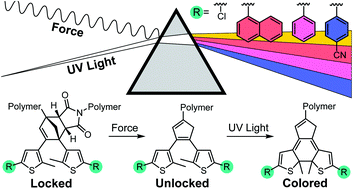A modular approach to mechanically gated photoswitching with color-tunable molecular force probes†
Abstract
Molecular force probes conveniently report on mechanical stress and/or strain in polymers through straightforward visual cues. Unlike conventional mechanochromic mechanophores, the mechanically gated photoswitching strategy decouples mechanochemical activation from the ultimate chromogenic response, enabling the mechanical history of a material to be recorded and read on-demand using light. Here we report a completely redesigned, highly modular mechanophore platform for mechanically gated photoswitching that offers a robust, accessible synthesis and late stage diversification through Pd-catalyzed cross-coupling reactions to precisely tune the photophysical properties of the masked diarylethene (DAE) photoswitch. Using solution-phase ultrasonication, the reactivity of a small library of functionally diverse mechanophores is demonstrated to be exceptionally selective, producing a chromogenic response under UV irradiation only after mechanochemical activation, revealing colored DAE isomers with absorption spectra that span the visible region of the electromagnetic spectrum. Notably, mechanically gated photoswitching is successfully translated to solid polymeric materials for the first time, demonstrating the potential of the masked diarylethene mechanophore for a variety of applications in force-responsive polymeric materials.



 Please wait while we load your content...
Please wait while we load your content...